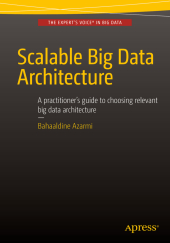 Neuerscheinungen 2015Stand: 2020-02-01 |
Schnellsuche
ISBN/Stichwort/Autor
|
Herderstraße 10
10625 Berlin
Tel.: 030 315 714 16
Fax 030 315 714 14
info@buchspektrum.de |

Bahaaldine Azarmi
Scalable Big Data Architecture
A practitioners guide to choosing relevant Big Data architecture
1st ed. 2015. xiii, 141 S. 70 SW-Abb. 254 mm
Verlag/Jahr: SPRINGER, BERLIN; APRESS 2015
ISBN: 1-484-21327-0 (1484213270)
Neue ISBN: 978-1-484-21327-8 (9781484213278)
Preis und Lieferzeit: Bitte klicken
This
book highlights the different types of data architecture and illustrates the
many possibilities hidden behind the term "Big Data", from the usage of No-SQL
databases to the deployment of stream analytics architecture, machine learning,
and governance.
Scalable
Big Data Architecture covers
real-world, concrete industry use cases that leverage complex distributed
applications , which involve web applications, RESTful API, and high throughput
of large amount of data stored in highly scalable No-SQL data stores such as
Couchbase and Elasticsearch. This book demonstrates how data processing can be
done at scale from the usage of NoSQL datastores to the combination of Big Data
distribution.
When
the data processing is too complex and involves different processing topology
like long running jobs, stream processing, multiple data sources correlation,
and machine learning, it´s often necessary to delegate the load to Hadoop or
Spark and use the No-SQL to serve processed data in real time.
This
book shows you how to choose a relevant combination of big data technologies
available within the Hadoop ecosystem. It focuses on processing long jobs,
architecture, stream data patterns, log analysis, and real time analytics. Every
pattern is illustrated with practical examples, which use the different open
sourceprojects such as Logstash, Spark, Kafka, and so on.
Traditional
data infrastructures are built for digesting and rendering data synthesis and
analytics from large amount of data. This book helps you to understand why you
should consider using machine learning algorithms early on in the project,
before being overwhelmed by constraints imposed by dealing with the high
throughput of Big data.
Scalable
Big Data Architecture is for
developers, data architects, and data scientists looking for a better
understanding of how to choose the most relevant pattern for a Big Data project
and which tools to integrate into that pattern.
Chapter 1: I think I have a Big (data) Problem (20 pages)
Chapter Goal: This chapter aims to introduce you to the topology of common existing limitations when it comes to dealing with large amounts of data, and what are the common solutions to those problems. The goal here is to lay down the foundation of a heterogeneous architecture that will be described in the following chapters.
1- Identifying Big Data symptoms
2- Understanding the Big Data projects ecosystem
3- Creating the foundation of a long term Big Data architecture
Chapter 2: Early Big Data with No-SQL (30 pages)
Chapter Goal: This chapter aims to describe how a No-SQL database can be a starting point for your Big Data project, how it can deal with large amounts of data, what are the limits of this model and how it can be scaled to a full-fledged Big Data project.
1- Choosing the right No-SQL database
2- Introduction to Couchbase
3- Introduction to Elasticsearch
4- Using No-SQL cache in a SQL based architecture
Chapter 3: Big Data processing jobs topology (30 pages)
Chapter Goal: The more data you get, the more important it is to split the processing into different jobs depending on the topology of the processing.
1- Big Data Job processing strategy
2- Smart data extraction from No-SQL database
3- Short term processing jobs.
4- Long term processing jobs.
Chapter 4: Big Data Streaming Pattern (30 pages)
Chapter Goal: This chapter helps the readers to understand what are their options when it comes to dealing with streaming high data throughput.
1- Identifying streaming data sources
2- Streaming with Big Data projects (Flume) versus Enterprise Service Bus
3- Processing architecture for stream data
Chapter 5: Querying and Analysing Patterns (30 pages)
Chapter Goal: In this chapter, the readers will understand how to leverage the processing work through long term & real time data querying.
1- "Process then Query" strategy versus real-time querying
2- Process, store and query data in Elasticsearch
3- Real-Time querying using Spark
Chapter 6: How About Learning from your Data? (30 pages)
Chapter Goal: This chapter will introduce the concept of machine learning at different level of the preceding described patterns and through different relative methodology.
1- Introduction to machine learning
2- Supervised and Unsupervised learning
3- A simple example of Machine learning
4- Using MLlib for machine learning
Chapter 7: Governance Considerations (20 pages)
Chapter Goal: Monitoring, and more generally governance is extremely important when dealing with architecture that involves all the previous patterns. This chapter is to safeguard the reader from major issues, and to gain visibility and control over the architecture.
1- Data Quality
2- Architecture Scalability
3- Security
4- Monitoring


